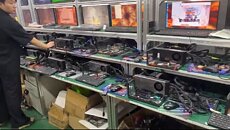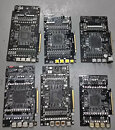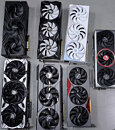- Joined
- Aug 19, 2017
- Messages
- 2,651 (0.99/day)
The recent U.S. government restrictions on AI hardware exports to China have significantly impacted several key semiconductor players, including NVIDIA, AMD, and Intel, restricting them from selling high-performance AI chips to Chinese land. This ban has notably affected NVIDIA's GeForce RTX 4090 gaming GPUs, pushing them out of mainland China due to their high computational capabilities. In anticipation of these restrictions, NVIDIA reportedly moved a substantial inventory of its AD102 GPUs and GeForce RTX 4090 graphics cards to China, which we reported earlier. This could have contributed to the global RTX 4090 shortage, driving the prices of these cards up to 2000 USD. In an interesting turn of events, insiders from the Chinese Baidu forums have disclosed that specialized factories across China are repurposing these GPUs, which arrived before the ban, into AI solutions.
This transformation involves disassembling the gaming GPUs, removing the cooling systems and extracting the AD102 GPU and GDDR6X memory from the main PCBs. These components are then re-soldered onto a domestically manufactured "reference" PCB, better suited for AI applications, and equipped with dual-slot blower-style coolers designed for server environments. The third-party coolers that these GPUs come with are 3-4 slots in size, whereas the blower-style cooler is only two slots wide, and many of them can be placed in parallel in an AI server. After rigorous testing, these reconfigured RTX 4090 AI solutions are supplied to Chinese companies running AI workloads. This adaptation process has resulted in an influx of RTX 4090 coolers and bare PCBs into the Chinese reseller market at markedly low prices, given that the primary GPU and memory components have been removed.



Below, you can see the dismantling of AIB GPUs before getting turned into blower-style AI server-friendly graphics cards.




For assurance that these cards work, factories are stress-testing them after modifications in Furmark, 3DMark, and AI applications, probably running some smaller LLMs locally to test their compute capability. Indeed, this process could potentially brick a lot of AD102 GPUs if not handled with care, but the yields of this experiment are unknown to anyone outside these factories.
View at TechPowerUp Main Site | Source
This transformation involves disassembling the gaming GPUs, removing the cooling systems and extracting the AD102 GPU and GDDR6X memory from the main PCBs. These components are then re-soldered onto a domestically manufactured "reference" PCB, better suited for AI applications, and equipped with dual-slot blower-style coolers designed for server environments. The third-party coolers that these GPUs come with are 3-4 slots in size, whereas the blower-style cooler is only two slots wide, and many of them can be placed in parallel in an AI server. After rigorous testing, these reconfigured RTX 4090 AI solutions are supplied to Chinese companies running AI workloads. This adaptation process has resulted in an influx of RTX 4090 coolers and bare PCBs into the Chinese reseller market at markedly low prices, given that the primary GPU and memory components have been removed.



Below, you can see the dismantling of AIB GPUs before getting turned into blower-style AI server-friendly graphics cards.




For assurance that these cards work, factories are stress-testing them after modifications in Furmark, 3DMark, and AI applications, probably running some smaller LLMs locally to test their compute capability. Indeed, this process could potentially brick a lot of AD102 GPUs if not handled with care, but the yields of this experiment are unknown to anyone outside these factories.
View at TechPowerUp Main Site | Source





